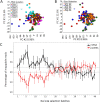Plasma extracellular RNA profiles in healthy and cancer patients
- PMID: 26786760
- PMCID: PMC4726401
- DOI: 10.1038/srep19413
Plasma extracellular RNA profiles in healthy and cancer patients
Abstract
Extracellular vesicles are selectively enriched in RNA that has potential as disease biomarkers. To systemically characterize circulating extracellular RNA (exRNA) profiles, we performed RNA sequencing analysis on plasma extracellular vesicles derived from 50 healthy individuals and 142 cancer patients. Of ~12.6 million raw reads for each individual, the number of mappable reads aligned to RNA references was ~5.4 million including miRNAs (~40.4%), piwiRNAs (~40.0%), pseudo-genes (~3.7%), lncRNAs (~2.4%), tRNAs (~2.1%), and mRNAs (~2.1%). By expression stability testing, we identified a set of miRNAs showing relatively consistent expression, which may serve as reference control for exRNA quantification. By performing multivariate analysis of covariance, we identified significant associations of these exRNAs with age, sex and different types of cancers. In particular, down-regulation of miR-125a-5p and miR-1343-3p showed an association with all cancer types tested (false discovery rate <0.05). We developed multivariate statistical models to predict cancer status with an area under the curve from 0.68 to 0.92 depending cancer type and staging. This is the largest RNA-seq study to date for profiling exRNA species, which has not only provided a baseline reference profile for circulating exRNA, but also revealed a set of RNA candidates for reference controls and disease biomarkers.
Figures





References
-
- Thery C., Ostrowski M. & Segura E. Membrane vesicles as conveyors of immune responses. Nat Rev Immunol 9, 581–93 (2009). - PubMed
-
- Vlassov A. V., Magdaleno S., Setterquist R. & Conrad R. Exosomes: current knowledge of their composition, biological functions, and diagnostic and therapeutic potentials. Biochim Biophys Acta 1820, 940–8 (2012). - PubMed
Publication types
MeSH terms
Substances
Grants and funding
LinkOut - more resources
Full Text Sources
Other Literature Sources
Molecular Biology Databases

